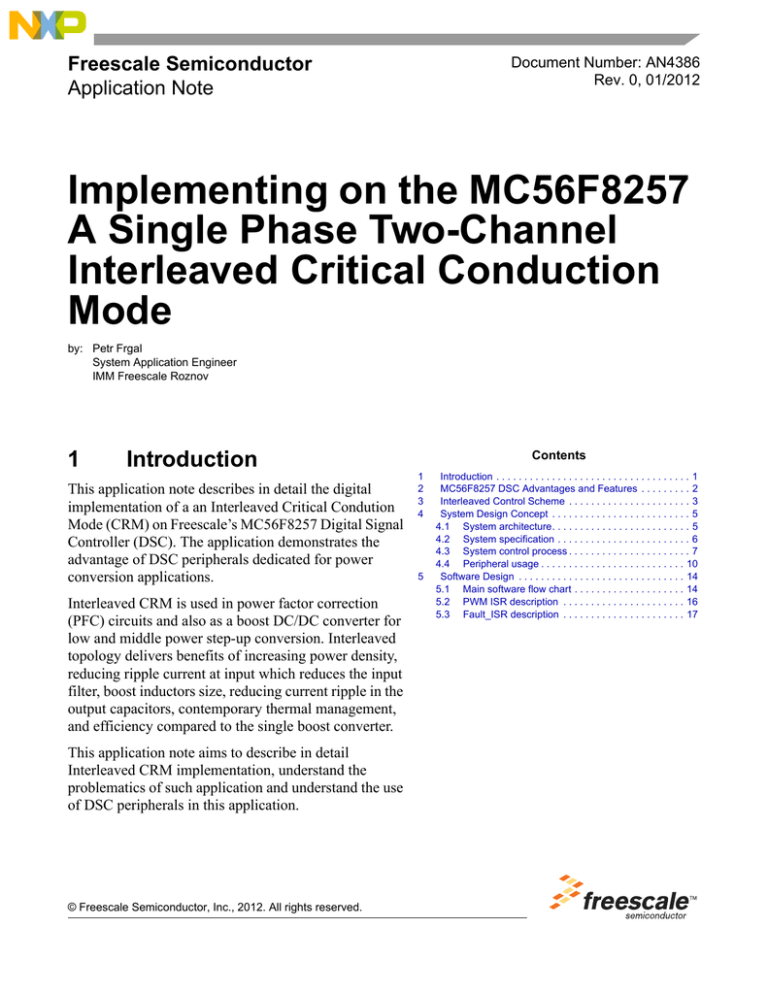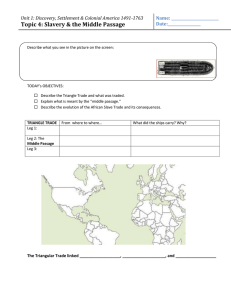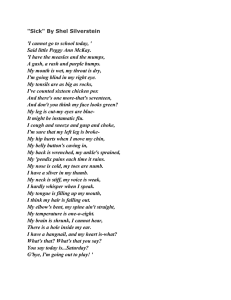
Freescale Semiconductor
Application Note
Document Number: AN4386
Rev. 0, 01/2012
Implementing on the MC56F8257
A Single Phase Two-Channel
Interleaved Critical Conduction
Mode
by: Petr Frgal
System Application Engineer
IMM Freescale Roznov
1
Introduction
This application note describes in detail the digital
implementation of a an Interleaved Critical Condution
Mode (CRM) on Freescale’s MC56F8257 Digital Signal
Controller (DSC). The application demonstrates the
advantage of DSC peripherals dedicated for power
conversion applications.
Interleaved CRM is used in power factor correction
(PFC) circuits and also as a boost DC/DC converter for
low and middle power step-up conversion. Interleaved
topology delivers benefits of increasing power density,
reducing ripple current at input which reduces the input
filter, boost inductors size, reducing current ripple in the
output capacitors, contemporary thermal management,
and efficiency compared to the single boost converter.
This application note aims to describe in detail
Interleaved CRM implementation, understand the
problematics of such application and understand the use
of DSC peripherals in this application.
© Freescale Semiconductor, Inc., 2012. All rights reserved.
Contents
1
2
3
4
5
Introduction . . . . . . . . . . . . . . . . . . . . . . . . . . . . . . . . . . . 1
MC56F8257 DSC Advantages and Features . . . . . . . . . 2
Interleaved Control Scheme . . . . . . . . . . . . . . . . . . . . . . 3
System Design Concept . . . . . . . . . . . . . . . . . . . . . . . . . 5
4.1 System architecture. . . . . . . . . . . . . . . . . . . . . . . . . 5
4.2 System specification . . . . . . . . . . . . . . . . . . . . . . . . 6
4.3 System control process . . . . . . . . . . . . . . . . . . . . . . 7
4.4 Peripheral usage . . . . . . . . . . . . . . . . . . . . . . . . . . 10
Software Design . . . . . . . . . . . . . . . . . . . . . . . . . . . . . . 14
5.1 Main software flow chart . . . . . . . . . . . . . . . . . . . . 14
5.2 PWM ISR description . . . . . . . . . . . . . . . . . . . . . . 16
5.3 Fault_ISR description . . . . . . . . . . . . . . . . . . . . . . 17
MC56F8257 DSC Advantages and Features
This application note will help application engineers make easier implementing this application in power
factor correction circuitries where input power is AC or in applications where DC voltage needs to be
boosted to a higher level, such as in a solar inverter or battery powered applications.
This application note includes interleaved control scheme, system design concept, peripheral setup and
usage, and software design.
The MC56F8257 is member of the DSC family that uses the 56800E core. Main advantages and features
of this controller are described in following section.
2
MC56F8257 DSC Advantages and Features
The MC56F82xx digital signal controller family combines on a single chip, the processing power of a DSP
and the functionality of a microcontroller with a flexible set of peripherals to create a cost-effective
solution. Because of its low cost, configuration flexibility, and compact program code, it is well-suited for
many applications. The MC56F8257 includes many peripherals that are especially useful for cost-sensitive
applications, including:
• Switched-mode power supplies and power management
• Solar Inverters
• Battery chargers and management
• Power metering
• Lighting ballast
• Motor control
• Industrial control
• Home appliances
• Smart sensors
The MC56F8257 provides the following peripherals:
• One Enhanced Flex Pulse Width Modulator (eFlexPWM) module
• Two independent 12-bit analog-to-digital converters (ADCs)
• Inter-Crossbar Switch (XBAR)
• Three analog comparators (CMPs)
• One 12-bit digital-to-analog converter (12-bit DAC)
• Two four-channel 16-bit multi-purpose timer (TMR) modules
• Two queued serial communication interface (QSPI) modules with LIN slave function
• One queued serial peripheral interface (QSPI) module
• Two inter-integrated cicuit (I2C) ports
• One Freescale Scalable Controller Area Network (MSCAN) module
• Computer operationg properly (COP) watchdog timer capable of selecting different clock sources
• Power supervisor (PS)
• Phase lock loop (PLL) providing a high-speed clock to the core and peripherals
Implementing on the MC56F8257 A Single Phase Two-Channel Interleaved Critical Conduction Mode, Rev. 0
2
Freescale Semiconductor
Interleaved Control Scheme
•
•
•
•
Clock source
Cyclic redundancy check (CRC) Generator
Up to 54 gereal-purpose I/O (GPIO) pins
JTAG.EOnCE debug programming interface for real-time debugging
The interleaved boost converter system benefits from the eFlexPWM module, High speed comparator
(HSCMP) module, Timer (TMR) module, Analog to Digital Converters (ADC) and Voltage reference
(VREF_DAC). All these modules offer flexibility in its configuration enabling efficient two-channel
interleaved Critical Conduction mode control. The configuration of each peripheral used in this application
are described in detail in Section 4.4, “Peripheral usage.”
3
Interleaved Control Scheme
The system configuration and key waveforms are shown in Figure 1. The switch Q1 (Q2) is turned on
when the corresponding inductor current reaches zero. The turn-on time is constant. Because of the high
current and voltage ripples, interleaving operation is used to reduce the current and voltage stress. In
converters operating with constant switching frequency interleaving can be easily achieved. For converters
operating in critical conduction mode interleaving is more difficult. The interleaving signal can be
generated from a turn-on or turn-off signal by shifting the signal with half of a switching period. The
interleaving control scheme used here shifts the slave turn-on signal to achieve interleaving. The master
phase is turned on by zero current detectors. Turn-on time is given by Voltage controller. Assume that
the difference between the two adjacent operation periods can be omitted. As a result, the previous
operation period to determine the present shift period can be used. For high switching frequency operation
(tens to hundreds kilo Hertz), this assumption is feasible.
Implementing on the MC56F8257 A Single Phase Two-Channel Interleaved Critical Conduction Mode, Rev. 0
Freescale Semiconductor
3
Interleaved Control Scheme
L1
ID1
ID2
IIN
L2
Q1
IC
C
RLOAD
ILOAD
Q2
MASTER
Q1
SLAVE
Q2
IL1
IIN/2
IL2
IIN/2
ID1
ID2
IC
Figure 1. Interleaved boost converter
The slave leg switch is turned-on by shifting the driving signal for the master leg by 180°. Turn-on times
for both legs are equal. If each leg has different parameters the slave leg can then work in continuous
conduction mode (CCM) or in discontinuous conduction mode (DCM). The different parameters can be
boost inductances, MOSFET parameters, sensing resistors, and also driving circuits. Algorithm for
master/slave leg identification is used for satisfying master leg operation in CRM and slave leg operation
in CRM or slightly in DCM.
Because the inductor currents are 180 degree out of phase, they cancel each other reducing the input ripple
current. The input ripple current and the inductor current varies with the duty cycle change. The best
input ripple current cancellation happens at a 50% duty cycle. The duty cycle of the step-up converter
operating from dc input varies with the input voltage. The inductor ripple current cancellation is constant
during constant input voltage. The duty cycle of the CRM PFC converter is variable with input voltage and
Implementing on the MC56F8257 A Single Phase Two-Channel Interleaved Critical Conduction Mode, Rev. 0
4
Freescale Semiconductor
System Design Concept
phase angle changing. Based on this, the inductor ripple current cancellation will not be 100% in
the whole grid period on PFC circuit, but it is dramatically decreased.
The inductor ripple current cancellation allows reduction of the boost inductor size. This is due to the
energy storage requirement of the two interleaved inductors being half that of single stage conveter
designed for the same power level, switching frequency and inductance.
In general, the DM noise is related to the input ripple current. The DM noise of the CRM is much
larger than CCM in the single phase converter. However, the DM noise of a two phase interleaving boost
converter is much smaller than the single phase CCM and CRM converter. Therefore, the DM-EMI
filter size is smaller.
The output capacitor current is the sum of the two diode currents. Interleaving reduces the output
capacitor ripple current as a function of duty cycle. As the duty cycle approaches 0 percent, 50 percent
and 100 percent duty cycle, the sum of the two diode currents approaches dc. At these points, the output
capacitor only has to filter the inductor ripple current. This reduction in RMS current will reduce electrical
stress in the output capacitor and improve converter reliability.
Based on all the benefits mentioned, the power density of the system can be significantly increased.
Drawbacks of the interleaved approach are that there area more components, and complicated control
algorithm. This is not such real disadvantage because the algorithm can be easily implemented and tuned,
and also reused for another application.
4
System Design Concept
4.1
System architecture
The application system incorporates the high voltage power stage, signal conditioning stage, auxiliary
power supply stage, and the controller stage based on the MC56F8257. The system architecture is depicted
in Figure 3.
Implementing on the MC56F8257 A Single Phase Two-Channel Interleaved Critical Conduction Mode, Rev. 0
Freescale Semiconductor
5
System Design Concept
Power
Stage
Driver
VREF_C
VIN
VREF_A
VREF_B
Vout
- +
- +
Signal
conditioning
- +
EFPWM
FAULT
ZX2
D
ZX1
ADC
QTIMER
voltage
controller
ADC
-
Ureq. +
Controller
Signal
conditioning
Auxiliary
Power
Supply
Figure 2. System block diagram for a single-phase two-channel interleaved boost PFC
The power stage consists of two parallel connected boost converters operating in critical conduction mode.
The interleaved approach has more components than the single boost converter. The control algorithm is
complicated, but the components are smaller with lower operating limits and can reach a better overall
performance and power density. As hardware is designed for the micro-solar inverter the EMI filter and
bridge rectifier is skipped in case of PFC circuit.
The sensing circuitries are used for sensing input voltage, output voltage, and leg currents, accommodating
them to the controller acceptable voltage level.
The drivers are used for amplification of driving PWM signal for boost converters MOSFET transistors.
The core of the controller stage side is the MC56F8257 controller on the controller board connected via
two 40-pin connectors. The MCU controls all the circuits mentioned above.
4.2
System specification
The application meets the following performance specification:
• Hardware used
Implementing on the MC56F8257 A Single Phase Two-Channel Interleaved Critical Conduction Mode, Rev. 0
6
Freescale Semiconductor
System Design Concept
•
•
4.3
— Power Stage board
— MC56F8257 controller board
Control technique incorporates:
— Constant on-time control (voltage control)
— DC-bus voltage loop (2 kHz control frequency and a variable switching frequency)
Fault protection:
— DC-bus over-voltage
— Input under-voltage and over-voltage
— Both legs over-current and cycle by cycle current limitation
System control process
This converter is operating in MASTER/SLAVE mode and therefore the control scheme in this application
can be designed according to a traditional single-channel converter. The function of this converter
operating in voltage mode control is to control the output voltage and keep it stable during load variation.
One DC bus voltage control loop is implemented is the system to meet steady state and dynamic
requirements for interleaved boost converter operating in CRM.
The DC bus voltage loop is meant to:
• Control the DC bus voltage to quickly follow the change of reference voltage and implement
non-error control in steady state
• Determine the permitted maximum current output through limiting the voltage regulator output
• Provide a timely anti-jamming function against the change of load
Tto achieve a good performance of the DC bus voltage loop a PI controller is used.
Figure 4 shows the system control scheme of a single-phase two-channel interleaved boost converter.
When the start-up phase is reached, the reference DC bus voltage is increased with a ramp according to
the required DC bus voltage. The comparison between the reference DC bus voltage and the actual
measured DC bus voltage generates a DC bus voltage error. Based on the error, the DC bus voltage
controller generates the output voltage for both channels of the PWM modulator. After the DC bus required
value is reached, the DC bus controller is keeping an output voltage on the required level and operating in
Run mode. If the switching period (output power) is below 20% slave leg stops to generate the PWM signal
and thereafter only the master leg is operating. More details relating operating one or both legs are in
Section 4.3.4, “Phase management.”
Implementing on the MC56F8257 A Single Phase Two-Channel Interleaved Critical Conduction Mode, Rev. 0
Freescale Semiconductor
7
System Design Concept
Vout_req
Ramp
Vout_ref +
Vout_error
Duty cycle
(MASTER)
PI controller
PWM
modulator
-
Vout_measured
Duty cycle
(SLAVE)
Vout_measured
Slave Delay
Calculation
V input
Figure 3. System control scheme of single-phase two-channel interleaved boost converter
To protect the converter againts undesirable performance ,software safety features are implemented. These
safety features are enumerated in Section 4.2, “System specification”.
As this interleaved converter operates in MASTER/SLAVE mode the identification routine of which leg
is master and which slave is important. A routine is executed every start-up of the application. The details
of this algorithm are summarized in section Section 4.3.2, “Master/slave identification”.
When slave leg operation is required based on an increased output power, it needs synchronization with
MASTER leg, it is important for a correct interleaved operation. See section Section 4.3.3, “Master/slave
synchronization” for more details.
4.3.1
Over current and cycle by cycle limitation
Two over-current fault signals are available in this design. Each over-current signal serves for over-current
protection with the support cycle by a cycle current limitation for each converter leg. The over-current
threshold value can be set in software only changing VREF_DAC_x (A, B or C) values. Both fault signals
are internally connected via XBAR to PWM Fault 0 and Fault 1 signal and both trigger Fault_ISR. Detail
Fault_ISR processing is depicted in section x.x Fault_ISR.
4.3.2
Master/slave identification
The parameters of each leg of the boost converter are not identical. The inductances, mosfet parameters,
sensing resistors, and control circuits which generate PWM signals can vary. Therefore, generating the
same PWM signals for each leg does not generate the same output voltage. It is also difficult to
synchronize both legs to operate in interleaved and critical conduction mode. The master/slave algorithm
is used for identifing what converter leg switching period takes longer for the same duty cycle. That
converter leg is the master leg.
This algorithm is executed one time in the AppStartUp state. During algorithm execution it captures timer
values, several times. These timere values represent the switching period from Timer B0 for leg 1, which
is summarized and the average value calculated from this sum. The same capturing values from Timer B1
and sum for the leg 2. The average switching period value is bigger and that leg is the MASTER leg. The
MASTER leg then operates in critical conduction mode and slave leg too or slightly in discontinuous
mode. Operation in continuous conduction mode of slave leg is therefore eliminated.
Implementing on the MC56F8257 A Single Phase Two-Channel Interleaved Critical Conduction Mode, Rev. 0
8
Freescale Semiconductor
System Design Concept
4.3.3
Master/slave synchronization
When both leg operations are required the SLAVE leg is synchronized with the MASTER leg. The driving
signal for the SLAVE leg lags the MASTER signal about half of the switching period. In critical
conduction mode the switching period can vary every switching cycle. Hardware and software support is
used for correct implementation of the interleaved critical conduction mode algorithm. Hardware
synchronization can be called the control where the slave delay time is based on capturing the switching
period by capturing timer values using Timer B0 and Timer B1. Software synchronizationcan be called the
control where slave delay time is calculated based on formula.
Software support is described detailly in section Section 4.3.5, “Slave delay calculation.” Software support
is needed because the synchronization signal based on the captured switching period using timers is
innacurate during transient.
4.3.4
Phase management
Nr. Of phases
operating
Phase management is the algorithm that judges if one leg or both legs will be operating. The decision
algorithm can be easily understand from Figure 4. Judge parameter is the MASTER switching period. The
maximum switching period is normalized and relates to the maximum output power. This feature is useful
for operating on a low load that one leg can be switched off and a higher overall efficiency reached.
2
1
0
20 30
50
100
Normalized
switching period
Figure 4. Phase management operation
4.3.5
Slave delay calculation
As a slave is lagged half of the switching period and the switching period can be calculated using the
equation in Figure 6. It can be used for slave leg sychronization with the master leg.
The switching cycle generally consist of two phases—when the switch is on (t-on time) and when the
switch off (t-off time)—this is conduction time. During t-on time, the input voltage is applied on the coil
and current is increases linearly see Figure 5.
Implementing on the MC56F8257 A Single Phase Two-Channel Interleaved Critical Conduction Mode, Rev. 0
Freescale Semiconductor
9
System Design Concept
Current
ICOIL(PEAK)
VIN/L
(VOUT-VIN)/L
Time
TON
TOFF
Figure 5. CRM switching cycle
During switch off time, the difference between output and input voltage is applied on the coil and current
flowing through coil is decreasing linearly. Next switching cycle begins when the coil current reaches zero.
Switching period is the sum of switch on and off time. Half of the switching period is the slave delay
synchronization signal and is expressed in the equation below.
Figure 6. Slave delay calculation equation
There:
t-on—On-time
Vout—Output voltage
Vin—Input voltage
4.4
Peripheral usage
The application uses only essential peripherals for the control technique implemented in the application
code—eFlexPWM, ADC, QTIMER, XBAR, VREF_DAC, and HSCMP (see Figure 3 for details). Other
peripherals are disabled. A peripheral initialization is executed using Freescale QuickStart tool which
offers a simple-to-use interface for all device peripheral settings. Detail configuration of used peripherals
are in the following sections.
4.4.1
QTIMER
The MC56F8257 contains two timer modules each with four timers. Each timer can operate as a timer or
as a counter. The counter provides the ability to count internal or external events. QTIMER_B0 and
Implementing on the MC56F8257 A Single Phase Two-Channel Interleaved Critical Conduction Mode, Rev. 0
10
Freescale Semiconductor
System Design Concept
QTIMER_B1 are used and operate in count mode. QTIMER_B0 is used for counting the switching period
for leg 1 and QTIMER_B1 for counting the switching period for leg 2. A configurated MC56F8257 Quad
Timer module B is as follows:
• QTIMER_B0
— Running at frequency 60 MHz (IPB clock/1)
— Capture rising edges of input T0 ( bus clock signal)
— Input capture on secondary source
— Secondary source is comparator B output (CMPB_OUT), CMPB_OUT signal is connected via
XBAR
• QTIMER_B1
— Running at frequency 60 MHz (IPB clock/1)
— Capture rising edges of input T0 (bus clock signal)
— Input capture on secondary source
— Secondary source is comparator C output (CMPC_OUT), CMPC_OUT signal is connected via
XBAR
4.4.2
XBAR
The crossbar switch module implements an array of 30 outputs and 22 inputs of combinational digital
multiplexes. All 30 multiplexes share the same 22 inputs in the same order, but each multiplex has its own
independent select field.
This module is designed to provide a flexible crossbar switching matrix that allows any input (typically
from external GPIO or internal module outputs) to be connected to any output (typically to external GPIO
or internal module inputs) under user control. This is used to allow user configuration of data paths
between internal modules and between internal modules and GPIO.
The application configuration is done as follows:
• Channel 6. ADCA Trigger
— PWM0_TRIG_COMB signal is used for ADC synchronization
• Channel 16. PWM submodule 0 External synchronization signal
— CMPB_OUT signal is used for PWM synchronization
• Channel 17. PWM submodule 1 External synchronization signal
— CMPC_OUT signal is used for PWM synchronization
• Channel 21. PWM module Fault0
— CMPA_OUT/ CMPB_OUT/CMPC_OUT signal is used as the PWM fault signal
• Channel 22. PWM module Fault1
— CMPA_OUT/ CMPB_OUT/CMPC_OUT signal is used as the PWM fault signal
• Channel 26. Quad Timer B0 Input
— CMPB_OUT signal is used as secondary source input signal
• Channel 27. Quad Timer B1 Input
Implementing on the MC56F8257 A Single Phase Two-Channel Interleaved Critical Conduction Mode, Rev. 0
Freescale Semiconductor
11
System Design Concept
— CMPC_OUT signal is used as secondary source input signal
4.4.3
eFlexPWM
Enhanced Flex Pulse Width Modulator is a dedicated peripheral that enables generation for driving PWM
signals for MOSFET transistors. PWM_A driving signal from the PWM submodule 0 is used for driving
MOSFET for leg 1. PWM_B driving signal for the PWM submodule 1 is used for driving MOSFET from
leg 2.
Two PWM submodules are used configurate as follows:
• PWM submodule 0
— Clock source IPBus clock
— Running at variable frequency
— INIT value = 0
— VAL1 modulo 2999 - resolution 11bits
— Independent mode
— PWM_A output in positive polarity is driving signal for MOSFET transistor
— Trigger 4 enabled provides synchronization signal for slave leg (PWM0_TRIG_COMB) in
case leg 1 it is the MASTER leg
— PWM middle cycle reload is generated every period
— External synchronization signal is selected—CMPB_OUT in case leg 1 is the MASTER leg or
PWM1_TRIG_COMB in case leg 1 is the SLAVE leg.
• PWM submodule 1
— Clock source IPBus clock
— running at variable frequency
— INIT value = 0
— VAL1 modulo 2999 - resolution 11bits
— Independent mode
— PWM_A output in positive polarity is driving signal for MOSFET transistor
— Trigger 4 enabled provides synchronization signal for slave leg (PWM1_TRIG_COMB) in
case leg 2 it is the MASTER leg
— PWM middle cycle reload is generated every period
— External synchronization signal is selected—CMPC_OUT in case leg 2 is the MASTER leg or
PWM0_TRIG_COMB in case leg 2 is the SLAVE leg.
• PWM Fault0 and Fault1
— Fault signals with HIGH level detection
— Fault clearing automatic
— Fault_ISR execution ( for details see chapter x.x Fault_ISR)
— Fault input filter disabled
Implementing on the MC56F8257 A Single Phase Two-Channel Interleaved Critical Conduction Mode, Rev. 0
12
Freescale Semiconductor
System Design Concept
4.4.4
ADC
The analog-to-digital (ADC) converter function consists of two separate 12-bit analog-to-digital
converters, each with eight analog inputs and its own sample and hold circuit.
The fast ADC converter module is configurated as follows:
— Input clock IPBus/6 = 10MHz
— Sample x set to DC-Bus voltage channel - ANAx
— Sample x set to DC-Bus voltage channel - ANAx
— Scan mode—Triggered parallel
— Trigger source—SYNC0 input ( PWM trigger connected via XBAR)
4.4.5
HSCMP
The High Speed Comparator module (HSCMP) provides a circuit for comparing two analog input
voltages. The comparator circuit is designed to operate across the full range of the supply voltage
(rail-to-rail operation). All three comparators are used for boost inductors current zero-crossing signal
detection and for over-current protection.
• HSCMP_A
— Over-current leg 1 protection or over-current leg 2 protection
• HSCMP_B
— Zero-crossing signal detection for leg 1 or over-current leg 1 protection
• HSCMP_C
— Zero-crossing signal detection for leg 2 or over-current leg 2 protection
4.4.6
VREF_DAC
The 5-bit VREF_DAC is a selectable voltage reference for applications that need a voltage reference. A
5-bit digital signal input selects the output voltage from 32 levels, which varies from VDDA to VDDA/32.
In this application all three voltage references are used as a threshold values for boost inductors current
zero-crossing signal and as an over-current threshold.
• VREF_A
— Over-current leg 1 threshold value or over-current leg 2 threshold value
• VREF_B
— Threshold value for boost inductor zero-crossing signal for leg 1 or over-current leg 1 threshold
value
• VREF_C
— Threshold value for boost inductor zero-crossing signal for leg 2 or over-current leg 2 threshold
value
Implementing on the MC56F8257 A Single Phase Two-Channel Interleaved Critical Conduction Mode, Rev. 0
Freescale Semiconductor
13
Software Design
5
Software Design
This section describes the software design of the one-phase two-channel interleaved boost converter
application operating in critical conduction mode. The system processing is interrupt driven with the
application state machine running in the background. The software is described in terms of the following:
• Main Software Flow Chart
• Application Interrupts —PWM_ISR and FAULT_ISR
Code can be easily incorporated into the target application as a part of the whole system because the
application is really independent from other tasks. Attention must be be taken onto correct timing of this
algorithm.
5.1
Main software flow chart
After a reset the application performs the following routines and enters the endless (main()) loop.
• PeripheralCoreInit
— Initialization of peripherals and controller core
• AppInit
— Initialization of application variables after reset
• archEnableInt
— Global intterupt flag enabled
Implementing on the MC56F8257 A Single Phase Two-Channel Interleaved Critical Conduction Mode, Rev. 0
14
Freescale Semiconductor
Software Design
Main software flow chart, see in Figure 7.
Reset
PeripheralCoreInit
AppInit
Enable interrupts
1
yes
AppStateMachine[uw8AppState]
Clear watchdog
Figure 7. Main SW Flow Chart
The application background main() loop contains the application state machine and clear watchdog timer.
The application state machine incorporates three states (see Figure 11):
• AppStartUp
— Master/slave indentification
— Voltage controller parameters setting for start-up and voltage controller enabling
— Soft start—Increasing required output voltage of the increment value until it reaches the
required DC-bus voltage value.
• AppRun
— Normal operation of control algorithm—DC-bus voltage is keept at the required value.
— Phase Management (algorithm described in section Section 4.3.4, “Phase management”).
• AppError
— Disables PWM outputs
Implementing on the MC56F8257 A Single Phase Two-Channel Interleaved Critical Conduction Mode, Rev. 0
Freescale Semiconductor
15
Software Design
CPU Reset
AppStartUp
AppRun
AppError
Figure 8. Application state machine
Transition between main states are performed using four transient states:
• AppStartUpToRun
— State is executed after DC-bus required value is reached, continue in Run mode
— Set voltage controller parameters for Run mode
• AppStartUpToError
— Set Error flag
• AppRunToError
— Set Error flag
• AppErrorToStartUp
— Clear Error flag
5.2
PWM ISR description
The PWM interrupt service routine performs the entire control algorithm. The algorithm consists of
subtasks which are:
• Read ADC quantities
• Phase management
• Slave leg synchronization with master
• Voltage Proportional-Intergral (PI) controller execution (every 500 s)
• Limit checking of all measured quantities
Implementing on the MC56F8257 A Single Phase Two-Channel Interleaved Critical Conduction Mode, Rev. 0
16
Freescale Semiconductor
Software Design
•
Update PWM registers
The PWM_ISR interrupt service routine is executed regularly every 62.5s. Initialization of the ADC
conversion is executed every 62.5s, and is initializated by the VAL0 value register. The conversion is
running in the background. The voltage PI controller design is well known and is described in detail in
many papers. The PWM ISR flow chart can be seen in figure 12.
Interrupt void PMW_ISR(void)
Read all ADC values
Phase management
(Master leg or both legs operation)
Slave leg synchronization with master leg
Calculate voltage PI controller, every
8th ISR (500μs)
Limit checking of all measured
quantities
Update all PWM registers
End of interrupt
Figure 9. PWM_ISR Flow Chart
5.3
Fault_ISR description
The Fault_ISR performs the over-current protection of each leg of the boost converter. This interrupt is
triggered by Fault0 and Fault1 in case of an over-current on any of the converter legs. Faults are configured
as the automatic clear mode to support the cycle-by-cycle current limit function. When the interrupt is
continuously triggered for a specified time the over-current fault is latched and the converter will shut
down. Therefore, this interrupt has a higher priority than the PWM_ISR interrupt. The flow chart of the
fault interrupt is shown in Figure 10.
Implementing on the MC56F8257 A Single Phase Two-Channel Interleaved Critical Conduction Mode, Rev. 0
Freescale Semiconductor
17
Software Design
Interrupt void Fault_ISR(void)
Initialize Fault timer (1st time in ISR)
If Fault timer > 100us
yes
Disable PWM
Set Error flag
Clear Fault timer
End of interrupt
Figure 10. FAULT_ISR Flow Chart
Implementing on the MC56F8257 A Single Phase Two-Channel Interleaved Critical Conduction Mode, Rev. 0
18
Freescale Semiconductor





